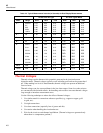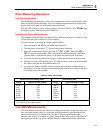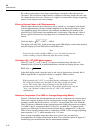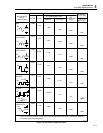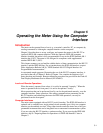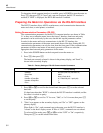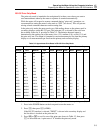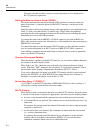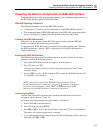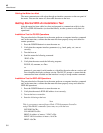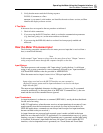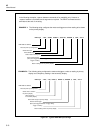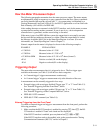
45
Users Manual
5-4
The meter exits the list editor, returns to normal operation, and is configured for
RS-232 print-only operations.
Cabling the Meter to a Host or Printer (RS-232)
The meter communicates with a host through a DB-9 interface connector on the rear
panel of the meter. A connector pinout for the RS-232 interface is on the rear of the
instrument.
Cable the meter to the host or terminal using a cable appropriate to your application (see
Table 1-1) that is less than 50 feet (15 meters) long. Longer cables are permitted,
providing that the load capacitance measured at the interface point (including the signal
terminator) does not exceed 2500 picofarads.
To connect the meter with an IBM PC/ AT (DB-9 connector), use both an RS40 and
RS41 cable connected end-to-end. Alternatively, a cable intended for interconnecting two
IBM PC/ATs can be used.
To connect the meter to a specific brand of RS-232 printer, use the cable that would be
used to connect that printer to an RS-232 port on an IBM PC/AT (DB-9 connector).
After cabling is complete, turn the meter back on, and you are now ready to operate the
meter over the RS-232 interface.
Character Echoing and Deletion
When the meter is operated via the RS-232 interface, you can control whether characters
are echoed to the host’s display screen.
When Echo is set "On", characters sent to the meter are echoed on the host’s display
screen. With Echo "OFF", characters are not echoed. To set the Echo parameter, refer to
the procedure under "Setting Communication Parameters (RS-232)", above.
If you send a character to the meter over the RS-232 interface directly from a keyboard,
pressing the <DELETE> or <BACKSPACE> key deletes the previous character. A
backspace is echoed to the display screen if Echo is "ON".
Device Clear Using ^C (CNTRL C)
^C (CNTRL C) is the RS-232 equivalent of IEEE-488 DCI (device clear), causing "=>"
followed by a carriage return and line feed to be output.
RS-232 Prompts
When the host sends a command to the meter over the RS-232 interface, the meter parses
it, executes it and returns a response (if appropriate), and sends you one of three prompts:
=> No errors were detected and the command was successfully parsed and executed.
?> A Command Error was detected. The command was not executed because it was not
understood.
For instance, this prompt would be returned if the meter was sent an input string that
contained a syntax error.
!> An Execution Error was detected. The command was understood but not executed
(i.e., a device-dependent error).
For instance, this prompt would be returned if you attempted to use the decibels
modifier (dB) on a frequency measurement (FREQ); or if you sent the meter
calibration commands when it was not in calibration mode.



